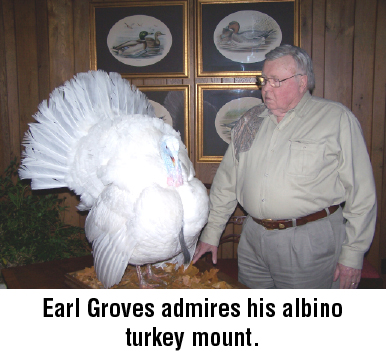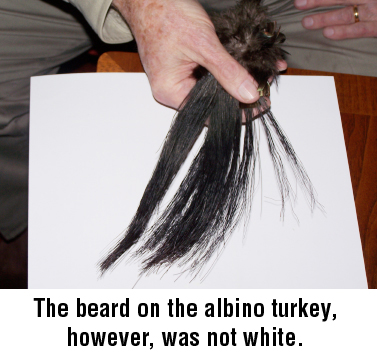I’ve hunted turkeys for more than 50 years, and am now in my 80s. In 2006, I killed my 500th gobbler. You’d think nothing could surprise me. But I could never have predicted what happened Spring 2008.
One of the many places I hunted that season was the Pine Ridge Indian Reservation in southwestern South Dakota. I hunted with Lance Christensen, of Kyle, S.D.
After arriving at Lance’s place, we went to take a look around. We spotted a huge snow-white gobbler in full strut about a half-mile away. As we got closer, we saw numerous other normal-colored birds around him — about 40 to 50 total turkeys. The white gobbler stood out distinctly from the rest. Was he a partially domestic bird? Was he a white color phase of a wild turkey, or could he be a true albino gobbler? We didn’t know.
We decided to find out. The next morning, Lance and I headed to where the white bird had roosted.
 As the sky brightened, gobblers in the trees below us began to sound off. I called more than I normally do to roosted birds. I wanted to encourage them to come up the steep hill and not stay in the valley below us. We heard wings flapping as turkeys started to fly down. After about 15 minutes, we heard a gobble that was obviously closer to us.
As the sky brightened, gobblers in the trees below us began to sound off. I called more than I normally do to roosted birds. I wanted to encourage them to come up the steep hill and not stay in the valley below us. We heard wings flapping as turkeys started to fly down. After about 15 minutes, we heard a gobble that was obviously closer to us.
A minute later, two gobblers popped over the edge of the bluff to our right and began walking toward us, beards swinging back and forth. They soon disappeared behind a large log, but I knew they were coming our way, so I didn’t call. Seconds later, the birds stepped into sight about 50 yards away, turned and headed toward me.
Suddenly, things changed. The snow-white gobbler burst around the end of the log at full speed and chased the other gobblers onto the prairie. Then, he circled back to the bluff and disappeared down the hill.
I yelped on my Lynch box call but got no response.
Just then, a large white blob appeared over the lip of the hill — the white gobbler in full strut. He marched onto the flat in front of us, walked on the far side of the log and disappeared for a minute or two. Then, he waddled into view 25 steps away. I was so excited that I forgot to try to get his head up. His head was facing sideways to me, so I drew a bead on it and dropped the bird in his tracks. What a moment.
 Lance and I hustled to the downed gobbler, full of curiosity. The turkey was no barnyard mixture. Instead, it was uniformly white, without any off-white feathers. His 8-inch beard was black, which is normal for an albino turkey, but that was it. I lifted the bird’s head and immediately saw its pink eyes. The bird also had bone-white spurs and toenails. It was a true albino gobbler and an awesome sight.
Lance and I hustled to the downed gobbler, full of curiosity. The turkey was no barnyard mixture. Instead, it was uniformly white, without any off-white feathers. His 8-inch beard was black, which is normal for an albino turkey, but that was it. I lifted the bird’s head and immediately saw its pink eyes. The bird also had bone-white spurs and toenails. It was a true albino gobbler and an awesome sight.
When we weighed the turkey, he was 26.5 pounds. We’d already determined that the bird was a 2-year-old, so the heavy weight was especially surprising. No doubt, that great size contributed to the white bird’s dominance.
That albino turkey was part of the best season I’ve experienced in my 80 years. There’s no way to top it. I finished with 22 trophy gobblers, including the albino bird and a five-bearded gobbler.
Now, as I sit in the winter of my life, I have a glorious, shining, once-in-a-lifetime season to remember.
For turkey hunting stories and strategies from the pros, click here to check out 99 Turkey Hunting Secrets.
